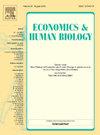The impact of biomedical innovation on cancer mortality in 37 countries, 2003–2017
IF 1.8
3区 医学
Q2 ECONOMICS
引用次数: 0
Abstract
Previous studies have shown that biomedical innovation, as measured by the long-run change in the vintage of MeSH descriptors of PubMed articles, has been the principal cause of declining cancer mortality in the U.S. The effect of biomedical innovation on cancer mortality outside of the U.S. may be different from its effect in the U.S. This study uses similar methods to investigate econometrically the impact that biomedical innovation had on cancer mortality in 37 countries during the period 2003–2017. Estimates based on pooled data by cancer site, country, and year indicate that the age-adjusted cancer mortality rate is significantly inversely related to the vintage of descriptors of PubMed articles about that cancer site 9–20 years (but not 0–8 years) earlier, controlling for the age-adjusted cancer incidence rate. The mortality rate is most strongly inversely related to the vintage of descriptors 16 years earlier. This finding is consistent with evidence from other studies that there is a substantial lag from biomedical innovation to population health. Excluding the U.S. (which accounts for 26 % of the cancer deaths in the 37 countries) from the sample does not have a substantial effect on the estimates. 85 % of the 2003–2017 decline in the cancer mortality rate is estimated to be attributable to the 1987–2001 increase in mean vintage. Only 6 % of the 2003–2017 decline in the cancer mortality rate is estimated to be attributable to the contemporaneous decline in the cancer incidence rate. In addition to estimating models using pooled data for many countries, we estimate models of the cancer mortality rate separately for each country. The estimate of the coefficient of vintage 16 years earlier is negative and significant for 24 of the 37 countries, and negative and marginally significant for 2 other countries; it is not positive and significant for any country. The population-weighted mean of the 37 estimates is very similar to the estimate from the model based on pooled data from many countries.
2003-2017年37个国家生物医学创新对癌症死亡率的影响
先前的研究表明,通过对PubMed文章的MeSH描述符的长期变化来衡量的生物医学创新,生物医学创新对美国以外癌症死亡率的影响可能与其在美国的影响不同。本研究使用类似的方法,对2003-2017年期间37个国家的生物医学创新对癌症死亡率的影响进行了计量经济学研究。基于癌症部位、国家和年份汇总数据的估计表明,年龄调整后的癌症死亡率与9-20年前(但不是0-8年前)PubMed文章中关于该癌症部位的描述符的年份显著负相关,控制了年龄调整后的癌症发病率。死亡率与16年前描述符的年份呈最强烈的负相关。这一发现与其他研究的证据一致,即从生物医学创新到人口健康存在重大滞后。从样本中排除美国(占37个国家癌症死亡人数的26% %)不会对估计产生实质性影响。据估计,2003-2017年癌症死亡率下降的85%可归因于1987-2001年平均年份的增加。据估计,2003-2017年癌症死亡率下降中只有6% %可归因于癌症发病率的同期下降。除了使用许多国家的汇总数据估计模型外,我们还对每个国家的癌症死亡率模型进行了单独估计。在37个国家中,24个国家的16年前年份的系数估计值为负且显著,另外2个国家为负且略微显著;这对任何国家来说都不是积极和重要的。37个估计值的人口加权平均值与基于许多国家汇总数据的模型估计值非常相似。
本文章由计算机程序翻译,如有差异,请以英文原文为准。
求助全文
约1分钟内获得全文
求助全文
来源期刊

Economics & Human Biology
医学-公共卫生、环境卫生与职业卫生
CiteScore
4.50
自引率
12.00%
发文量
85
审稿时长
61 days
期刊介绍:
Economics and Human Biology is devoted to the exploration of the effect of socio-economic processes on human beings as biological organisms. Research covered in this (quarterly) interdisciplinary journal is not bound by temporal or geographic limitations.
 求助内容:
求助内容: 应助结果提醒方式:
应助结果提醒方式:


